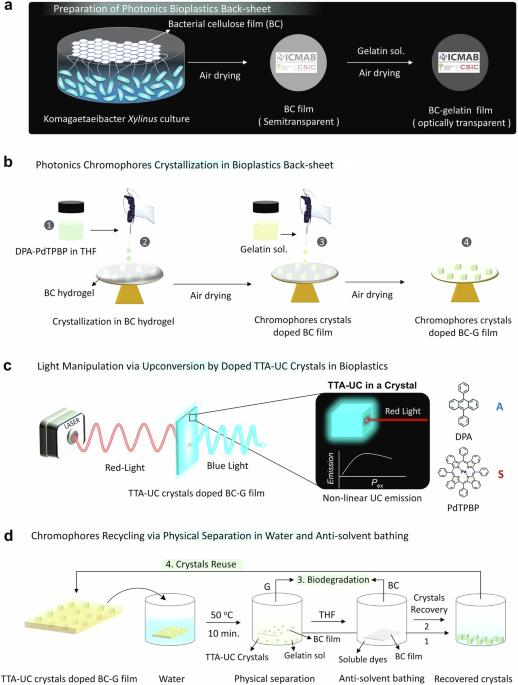Photon upconversion crystals doped bacterial cellulose composite films as recyclable photonic bioplastics
IF 7.5
Q1 MATERIALS SCIENCE, MULTIDISCIPLINARY
引用次数: 0
Abstract
Biopolymers currently utilized as substitutes for synthetic polymers in photonics applications are predominantly confined to linear optical color responses. Herein we expand their applications in non-linear optics by integrating with triplet-triplet annihilation photon upconversion crystals. A photon upconverting biomaterial is prepared by cultivating Pd(II) meso-tetraphenyl tetrabenzoporphine: 9,10-diphenyl anthracene (sensitizer: annihilator) crystals on bacterial cellulose hydrogel that serves both as host and template for the crystallization of photon upconversion chromophores. Coating with gelatin improves the material’s optical transparency by adjusting the refractive indices. The prepared material shows an upconversion of 633 nm red light to 443 nm blue light, indicated by quadratic to linear dependence on excitation power density (non-linearly). Notably, components of this material are physically dis-assembled to retrieve 66 ± 1% of annihilator, at the end of life. Whereas, the residual clean biomass is subjected to biodegradation, showcasing the sustainability of the developed photonics material. Biopolymers used in photonics are mainly limited to linear optical color responses. Here, photon upconversion crystals incorporated into bacterial cellulose films demonstrate non-linear optical applications in biopolymers.

作为可回收光子生物塑料的光子上转换晶体掺杂细菌纤维素复合薄膜
目前,光子学应用中用作合成聚合物替代品的生物聚合物主要局限于线性光学色彩反应。在这里,我们通过与三重-三重湮灭光子上转换晶体的整合,拓展了它们在非线性光学领域的应用。一种光子上转换生物材料是通过培养钯(II)介四苯基四苯甲吗啡制备的:9,10-二苯基蒽(增感剂:湮灭剂)晶体,该晶体既是光子上转换发色团结晶的宿主,又是其模板。明胶涂层通过调整折射率提高了材料的光学透明度。所制备的材料可将 633 纳米红光上转换为 443 纳米蓝光,这与激发功率密度(非线性)呈二次到线性关系。值得注意的是,这种材料的组件在使用寿命结束时会被物理分解,以回收 66±1% 的湮灭剂。而残留的清洁生物质则会发生生物降解,从而体现出所开发光子材料的可持续性。光子学中使用的生物聚合物主要局限于线性光学颜色响应。在这里,融入细菌纤维素薄膜的光子上转换晶体展示了生物聚合物中的非线性光学应用。
本文章由计算机程序翻译,如有差异,请以英文原文为准。
求助全文
约1分钟内获得全文
求助全文
来源期刊

Communications Materials
MATERIALS SCIENCE, MULTIDISCIPLINARY-
CiteScore
12.10
自引率
1.30%
发文量
85
审稿时长
17 weeks
期刊介绍:
Communications Materials, a selective open access journal within Nature Portfolio, is dedicated to publishing top-tier research, reviews, and commentary across all facets of materials science. The journal showcases significant advancements in specialized research areas, encompassing both fundamental and applied studies. Serving as an open access option for materials sciences, Communications Materials applies less stringent criteria for impact and significance compared to Nature-branded journals, including Nature Communications.
 求助内容:
求助内容: 应助结果提醒方式:
应助结果提醒方式:


